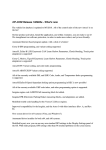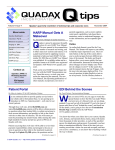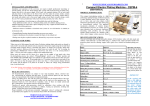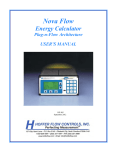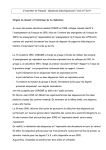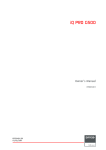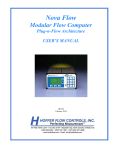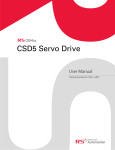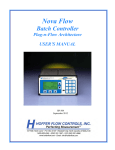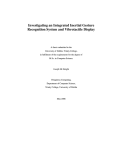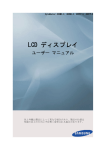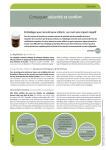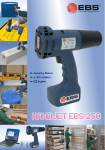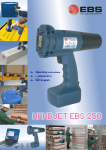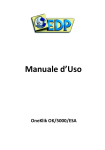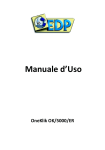Download User manual
Transcript
YACC — User Manual Yet Another Car Computer Yet Another Car Computer is do-ityourself electronic device addressed to middle skilled hobbyists. Opel cars are primary destination of YACC which works with cars displays, preserves genuine interior look and seems to be a factory device. Moreover, YACC can work with popular alphanumeric LCD displays. This feature, extended configuration and painless calibration method make possible to install YACC in practically every car equipped with fuel injection. Functions 1) Instantaneous speed measurement with precision of 0.1 km/h. Page 1 of 17 7) Used fuel gauge. Low fuel level warning: (a) estimation of fuel level in the tank, (b) distance estimation remaining on the tank given mileage. 8) Three trips. Each trip meters distance, average speed, time of journey, average and total fuel consumption and cost of fuel for longer periods of time. 9) Tachometer. 10) Battery voltage meter. 11) Manual steering of automatic antenna. It is possible not to use the antenna e.g. when listening to CD. nized. Pressing and holding the button for less than 1 second is called 9.5 < TANK CAP − F ≤ 10.5 a short press. Pressing and holding the button for more than 1 second is called a long press. Short presses cycle b) Estimated distance remaining on the display between successive working the tank (in kilometers). modes. Long presses are used to enter D124 51.4 commands (e.g. to reset fuel counter, This distance is calculated using to begin a trip etc.) current average fuel consumption A [ ] symbol is shown when a long FA. press is available. Working modes are shown on figures When the vehicle stops (condition 5, 6 and 7. Short presses are reprev < 0.5 km/h) the following values are sented by thin, vertical lines displayed. SPD M/A/T M 12005 12) Sport mode. 1/4 mile and 0. . .60, 0. . .80, 0. . .100 km/h runs. 2) Traveled distance measurement. Informations from points 2, 3, 4 and Automatically shown every time 5 are automatically displayed when vevehicle stops. hicle stops. While going through the city they give an interesting possibil3) Average speed measurement. Two ity of observations of mileage, comparvalues are measured: (a) total avison the average speed with the speed erage speed, (b) average speed corof e.g. bicycle, realizing how much time responding to motion i.e. only rewe spent in traffic jams and how big car ferring to periods of time when veexpenses are. hicle is moving. Instantaneous speed gives a chance to estimate how big an excess of factory 4) Time of journey and time when vespeedometer indication is. hicle is stopped measurement. Average fuel consumption corresponding to segment of the road fo5) Cost of used fuel. cuses our attention on big differences 6) Fuel consumption: (a) average depending on traffic conditions and since key was turned on, (b) in- driving style. stantaneous corresponding to last 5 second, (c) instantaneous cor- Using the YACC responding to road segment of length ranging from 50 to 1000 Single button is used to control the demeters. vice. Two types of presses are recog- a) Traveled distance in meters or for distances greater than 100 km in kilometers. RPM and long presses by thick, horizontal ones. TRIPS TRIP 1 Basic mode While driving instantaneous speed v is shown in km/h. SPD 50.2 If tank capacity (FUEL → TANK CAP) is set and an amount of fuel remaining in tank (difference between defined tank capacity and used fuel F) is lower than warning level (FUEL → WARN LEV), than the following data are shown instead of letters SPD. a) Tank fuel level (in liters). F10 50.2 Here F10 means that KM 1200.1 b) Average speed, excluding the time when the vehicle was stopped/total average speed in km/h. A 40/32.7 c) Total time of trip/time when vehicle was stopped in minutes. T 20/4 For total trip time greater than 60 minutes, both times are displayed one after another. Time of trip T 2H30 and time stopped. W 0H25 d) Fuel cost. EUR 20/4.5 when vehicle was YACC — User Manual The first value corresponds to TRIP 1 and is shown only for active trip. The second value corresponds to current traveled distance (since key was turned on). Distance, travel time and fuel cost measurements start each time when the key is turned on (precisely since the first moment when v ≥ 0.5 km/h) and end when the key is turned off. Tachometer The value of engine revolutions per minute is shown. RPM 1200 Average fuel consumption Average fuel consumption corresponding to traveled distance (since the key was turned on) is shown. The unit is l/100 km. FA 7.5 User can choose between displaying numerical values related to consumed fuel (averages FA, FH, FK, FX, fuel counter F) with accuracy of one or two decimal digits after decimal dot (FUEL → ACC). One should remember however, that TID allows to display decimal point between two most right digits only. With two digit accuracy result will be shown as integer with unit 0.01 l/100 km. FA 750 Instantaneous fuel consumption per hour Instantaneous fuel consumption corresponding to last 5 seconds is shown. The unit is l/h. FH 1.2 Page 2 of 17 Instantaneous fuel consumption corresponding to segment of the road Instantaneous fuel consumption corresponding to the preceding segment of the road of selected length (10 m, 20 m, 50 m, 100 m, 200 m, 500 m, 1 km) is shown. The unit is l/100 km. FK05 8.5 or FX05 8.5 Long press enters settings mode enabling to select length of the segment of the road. Next short presses cycles between values 10 m (FK01), 20 m (FK02), 50 m (FK05), 100 m (FK1), 200 m (FK2), 500 m (FK5), 1 km (F1K). Long press switches between FK and FX modes. In FK mode all amount of used fuel is included in calculations. In FX mode fuel used when vehicle was stopped is not included. YACC returns to main menu automatically after 5 second. switches to editor mode (EDIT) Trips where you enter the amount (in Trips allows to measure total distance, 0.01 l) of fuel added. time and used fuel for longer periods. c) CAL – choose this command when Long press in TRIPS you are filling your tank and want mode switches to trips related menu to use the data collected during where short presses cycle through sucthe past tank to calibrate your cessive trips (TRIP 1, TRIP 2, TRIP 3) fuel coefficient cf uel . Long press and command EXIT returning to main switches to editor mode (EDIT) menu — automatically after 5 seconds where you enter the amount (in or with a long press. 0.01 l) of fuel added during this For each trips following values are fill-up. displayed every 2 seconds d) PRICE – fuel price. Long press switches to editor mode (EDIT) where you enter fuel price in 0.01 currency unit. Currency symbol can be defined in FUEL → CURRENCY mode. e) EXIT – returns to previous menu. Automatically after 5 seconds or with a long press. a) trip number, e.g. TRIP 1 * b) traveled distance, c) average speed, d) time of trip, e) average fuel consumption, Fuel gauge f) total fuel consumption, The amount of fuel used so far is Fuel cost shown. The unit is l. F 31.2 Fuel cost corresponding to traveled disLong press enters the fuel related tance is shown. menu. Successive short presses cycle EUR 10.6 through following commands. g) fuel cost. a) RESET – counter reset. Use this command every time you fill up but don’t want to recalibrate fuel coefficient cf uel . Long press resets the counter and confirms with message DONE b) ADD – use this command every time you are filling your tank but not completely full. Long press Battery The battery voltage is shown. The unit is V. BATT 12.2 YACC switches to this mode immediately after key is turned on giving possibility to observe voltage drops when vehicle ignition is attempted. After 20 seconds YACC returns automatically to basic mode. Symbol * after number means that trip is active i.e. distance, time and fuel data are updated all the time. Lack of * means that trip was ended. Long press begins or ends the trip. If the trip is inactive the command BEGIN n is shown where n corresponds to trip number. Next long press resets all trip related data and marks trip as active. The action is confirmed with DONE Since that moment distance, time and fuel data will be updated all the time. If the trip is active the command END n YACC — User Manual Page 3 of 17 is shown. Next long press ends the trip. The action is confirmed with DONE YACC switches to BATT mode for 20 seconds immediately after key was turned on. During that time period a single long press resets and begins TRIP 1. During radio use a long press (if Defaults not connected with another command) changes antenna position to the oppo- Astra F site one. PRESETS → ASTRA F. Long press recalls default fuel measurement values for Astra F. Turning the key off Sport mode YACC turns off after 30 seconds of idleness. Long press in basic mode switches to sport mode. Short presses cycle through runs: 1/4 mile, 0. . .60, 0. . .80, 0. . .100 km/h. YACC automatically prepares to new run each time vehicle is stopped. Run name (1/4, 60, 80, 100) is shown on the left side and word ready RDY on the right one. 1/4 RDY Timing commences automatically upon detection any motion. The percent relative value of distance (speed) is shown on the left side. Run time in second is shown on the right side. 47% 10.2 At the end of the run timing stops and run name is shown once more on the left side. 1/4 21.0 Long press in sport mode switches back to basic mode. FUEL → COEF FUEL → SOURCE 3 669 000 L Astra G Configuration PRESETS → ASTRA G. Long press recalls Pressing and holding button for 5 sec- default fuel measurement values for Asonds in tachometer mode switches to tra G. configuration menu. A ”stereo” symbol FUEL → COEF 27 700 appears on 8–digit display and ”Dolby” FUEL → SOURCE F symbol on 10–digit one. 20 seconds idleness switches automatically back to basic mode. Speed and distance Calibration Editor Editor allows to enter numerical values and is available in selected working modes. Editor is always entered with a long press. Next short presses cycle through successive digits and commands CANCEL and SET. The SET command is visible only when a value has been changed and a new value is in proper range. Long press during SET command stores a value, ends editor Manual antenna steering mode and returns to the mode editor When you turn radio on an antenna was started from. Long press during CANCEL command status ends editor mode without any changes. ANT ON or Long press during digit selection ANT OFF switches into a mode which allows to is shown for 5 second. Short press change digit value. Short presses sechanges the state of the antenna to the lect new value and a long press accepts opposite one. it. SPEED → DISTANCE. Use the following procedure. Begin TRIP 1 and reset the mechanical distance counter at the same time. Travel some tens of kilometers. With a long press switch to editor mode and enter traveled distance in meters. The calibration coefficient cdist will be calculated automatically. One needs to remember that most mechanical counters work in two directions — count downward while going backward. YACC uses a pulser and does not distinguish directions. Instantanous speed averaging SPEED → NOISE. YACC uses a simple algorithm to achieve better precision of speed measurement. The measurement process lasts approximately SPEED → T MIN. Number of recorded impulses correspoding to traveled distance is divided by measurement time. Traveled distance impulses are generated by special devices called pulsers. Construction of pulsers varies. Very often they are based on rotating wheel. Mechanical inaccuracies of workmanship, looseness, axis and propel cable vibrations can cause additional errors. Figure 8 shows calculations of instantaneous speed based on recorded times of two successive impulses. Result analysis indicates that for this specific case pulser generates 15 impulses with every revolution. Therefore it would be better to use time periods corresponding to multiply of 15 impulses. In editor mode enter the value SPEED → NOISE in range 0. . .99. Value 0 turns averaging off. If during single measurement less than 2·SPEED → NOISE impulses are recorded (small speeds) than instantaneous speed is calculated without averaging. For other cases the biggest multiply of SPEED → NOISE impulses is used in calculations. Calibration coefficient Signal selection SPEED → COEF. In editor mode enter cdist value in range 1. . .65 535 equal to number of impulses corresponding to 1 km. SPEED → SOURCE. The letter R corresponds to rising edge and the letter F to falling one. Long press changes between R and F. YACC — User Manual Minimum measurement time Page 4 of 17 will be shown as integer with unit 0.01 l/100 km. SPEED → T MIN. In editor mode enter value in range 10. . .110 in hundred Calibration coefficient parts of second. FUEL → COEF. In editor mode enter cf uel value in range 1. . .99 999 999 equal to the sum of impulses lengths correSPEED → T MAX. In editor mode enter sponding to 1 liter of fuel. value in range 10. . .110 in hundred parts of second. Reading fuel consumption data 7A 7B 7C 8A 8B 8C Tachometer 04358 01599 57383 04346 01594 08461 Calibration coefficient RPM → COEF. Long presses cycle through subsequent crpm coefficient values: 1, 2, 3, 4, 5, 6, 12 , 31 , 14 , 51 , 16 . Maximum measurement time Fuel Tank capacity FUEL → TANK CAP. In editor mode enter tank capacity (value in range 0. . .250) in liters. Value 0 turns low fuel level warning off. Warning level FUEL → WARN LEV. In editor mode enter value in liters in range 0. . .99. Value 0 turns low fuel level warning off. Currency symbol FUEL → CURRENCY. In editor mode enter three letter currency symbol (e.g. EUR, USD etc.) Accuracy FUEL → ACC. Long press switches between displaying numerical values related to consumed fuel (averages FA, FH, FK, FX, fuel counter F) with accuracy of one or two decimal digits after decimal dot. One should remember however, that TID allows to display decimal point between two most right digits only. With two digit accuracy result FUEL → HISTORY. In this mode one can read data necessary to compute fuel consumption calibration coefficient cf uel . Short presses cycle between successive results. 20 seconds of idleness returns to basic mode. Results are shown in order reverse to chronological (1 — past fill, 2 — fill before past etc.) A single fill is represented by 3 values: A — amount of fuel in 0.01 liters, B — beginning 5 digits Σf , C — ending 5 digits of Σf . Example results. 1A 04328 1B 01855 1C 82273 2A 04409 2B 01619 2C 59814 3A 03844 3B 01313 3C 73735 4A 04163 4B 01538 4C 56441 5A 04312 5B 01553 5C 67922 6A 03736 6B 01389 6C 54037 Liters 1. 2. 3. 4. 5. 6. 7. 8. 43.28 44.09 38.44 41.63 43.12 37.36 43.58 43.46 Σf 185 161 131 153 155 138 159 159 582 959 373 856 367 954 957 408 273 814 735 441 922 037 383 461 Edge selection RPM → SOURCE. The letter R corresponds to rising edge and the letter F — falling one. Long press changes between R and F. Minimum measurement time We assume that amount of used fuel RPM → T MIN. In editor mode enter vf uel is proportional to total length Σf of value in range 10. . .110 in hundred parts of second. recorded impulses vf uel · cf uel = Σf The method used to obtain value of cf uel consists in filling up the fuel tank of car (until the pomp stops). However this method has potentially many errors like inaccuracy of the pomp work, the moment pomp stops, etc. Results are shown on figure 9. Points corresponding to fills 2, 4, 5, 6, 7 and 8 are approximately linear. Fills 1 and 3 have thick errors and has been excluded from further analisys. A straight line y = cf uel · x has been fitted with least square method. Maximum measurement time RPM → T MAX. In editor mode enter value in range 10. . .110 in hundred parts of second. Battery Calibration BATTERY → VOLTAGE. Measure a battery voltage with a multimeter. With a long press switch to editor mode and enter measured value in units 0.01 V. The calibration coefficient cbatt will be calculated automatically. Signal selection FUEL → SOURCE. The letter L selects length measure of low level, the letter H — high one, the letter R counts rising edges and F — falling ones.. Long press cycles through L, H, R, F. Calibration coefficient BATTERY → COEF. In editor mode enter cbatt value in range 1. . .65 535. The A/D converter resolution is equal to 10 bits. Value u =1 023 corresponds to voltage YACC — User Manual Page 5 of 17 For a single line the way of work cor1.1 V. The value shown in battery voltage mode BATT is calculated with the fol- responds to TID display. lowing formula. For two lines, the upper one displays instantaneous speed and estimation of cbatt · u fuel and distance remaining on your 10 000 tank. The lower line corresponds to TID display. Radio Manual antenna steering RADIO → ANT. Value YES enables and value NO disables manual antenna control. Long press changes value to opposit one. When manual steering is disabled antenna opens automatically with radio turning on and closes 10 second after turning radio off. Assembly in the car Supply Supply circuit uses low drop voltage regulator IC5. Key on voltage pulls PWR2 line low which in turn switches T1 transistor on and powers the microcontroller. Microcontroller keeps PWR4 line low during work and keeps power even after turning key off. Concurrently YACC monitors key on voltage by reading state of PWR1 line. Elements assembly on the circuit board is the first step. The microcontroller IC1 is mounted into a socket. YACC was designed for control button which switches the ground. This corresponds with 8–digit displays (e.g. Astra F). Second line offset In 10–digit displays (e.g. Astra-G) the dot button switches positive voltLCD → OFFSET. In the editor enter an age. In order to adjust YACC to work address (number in range 0. . .127) of A/D converter with 10–ditig displays you should omit the first character in the second line. assembling D3 diode and make two This option allows to deploy practically A/D converter input voltage range is additional connections on the circuit every model of LCD display. 0. . .1.1 V. Battery voltage measurement board. uses a divider with R4 and R5 resistors. A comprehensive description of asDiodes D1 and D2 protect A/D input. sembly is available on the web page TID display selection Connection with factory radio re- The YACC computer works with factory display used in Opel cars. There are ceiver two variants of displays with 8 or 10 RADIO → OPEL. Value YES allows to use digits. The proper display type can be factory radio receiver. When receiver is selected with 8/10 jumper. in use YACC does not send any data to TID. Value NO corresponds to constant 8/10 jumper access of YACC to TID display. If one open 8 digit display use factory radio with this setting data close 10 digit display collision will occur and none or random data will be displayed. However this will not lead to any disfunction. Construction Schematic diagrams are shown on figLCD display ures 10 and ??. The microcontroller IC1 running with clock 12 MHz and Display width supplied with 3.3 V is the main eleLCD → WIDTH. Select number of charac- ment. At such supply voltage the miters in a single line in range 12. . .20. crocontroller is slightly overclocked but works correctly. Low supply voltage guarantees Number of lines proper work of device when ignition LCD → LINES. Select number of lines is attempted what usually cause big (one or two). battery voltage drops. Outputs e-pmk.eu/en/diy/yacc/know-how IC2 and T2 are used to convert 3.3 V level signals into 12 V level ones. If you don’t intent to manually control automatic antenna than skip assembly of T2, R13 and R16 elements. YACC and LCD displays Due to users feedback the possibility of communication with popular LCD displays based on HD44780 driver has been added to the YACC computer. Inputs IC3 is used to convert 12 V level signals into 3.3 V level ones. Additionally for traveled distance signal (ICP), engine revolution signal (INT1) and fuel consumption signal (INT0) Schmidt triggers (built with IC4) can be used. Triggers are activated by jumpers according to the following table. Schmidt trigger bypassed used Connection The way of connection of LCD display to YACC computer is shown on figure 10. Connections have to be made with wires soldered directly to the points on printed circuit boards. Depending on the display type it could be necessary to use contrast regulation (R1 variable resistor) and/or backlight current restraint (R2 resistor). YACC — User Manual Page 6 of 17 Supply (real value for test car), the counter Measurement time is determined by range is over 250 000 km. two values: the minimum time SPEED Depending on current consumption by Additionally, times of the rising (R) → T MIN and maximum time SPEED → LCD display (backlight current ranging T MAX. One can apply own values to from tens to hundreds mA is the most u these coefficients to achieve the best significant factor) it would be necessary fit to own car. The measurement int t n+k n to use additional voltage regulator or cludes the lowest number k impulses might be possible to use existing one (not greater than 255), such that tn+k − (after substituting original IC5 LP2950tn >SPEED → T MIN. For big speeds the 3V3 circuit with +5V equivalent, e.g. measurement could last shorter than LP2950-5V0 or 78L05). SPEED → T MIN. When at least two impulses will not be recorded during SPEED t → T MAX time instantaneous speed is Display selection assumed to 0 and a new measurement Display selection is determined with or falling (F) starts immediately. PC3 input. Connecting the input with When the value of coefficient SPEED u the ground (with LCD/TID switch or → NOISE> 0 and the number of simply with wire) selects LCD display. recorded impulses k > 2·SPEED → NOISE tn+k tn Leaving the input unconnected selects only k̃ beginning impulses are considTID display. ered in the calculation, where k̃ ≤ k is the biggest multiple of SPEED → NOISE. Fuel mileage Fuel consumption is calculated from the length or count of impulses generated by Engine Control Module (ECM) or taken from signal driving injector. (a) Times of rising and falling edges are recorded with the same accuracy as in instantaneous speed measurement. Maximum length of impulse equals approximately 21 ms. Longer impulses are rejected. Times of impulses t2 − t1 and t4 − t3 corresponding to high (H) u t1 t2 t3 t4 Restoring factory settings Improper configuration can couse that t information will not be displayed properly. Closing 8/10 jumper and powering edges are recored. Edge type can be selected during configuration (SPEED → device restores factory settings: SOURCE mode). Resolution of measurements is equal approximately to 21 µs. LCD → WIDTH 12 According to the number of imLCD → LINES 1 pulses k and their times tn , tn+k instanLCD → OFFSET 64 taneous speed is calculated with the following formula Measurement methods Speed and distance Speed and distance measurements use electric impulses generated by a special device called pulser. Impulses are counted in 32–bit counter. Thus, assuming that 1 km corresponds to cdist = 16 900 impulses Engine revolution speed Measurement of engine revolution speed is analogous to measurement of instantaneous speed. The RPM value is calculated with the following formula or low (L) level respectively crpm · k · 46 875 · 60 tn+k − tn t h rev i min u t1 t2 t3 t4 Selection of the value crpm from set 1, 2, 3, 4, 5, 6, 21 , 13 , 14 , 15 , 16 (RPM → COEF mode) allows to fit to own car. 46 875 · 3 600 h km i k · Minimum and maximum times of cdist tn+k − tn h measurement are determined by RPM → Setting value of cdist coefficient in T MIN and RPM → T MAX configuration t range 1. . .65 535 makes it possible to settings. adjust device to every car. Suggested Measurement includes no more calibration method is explained in fur- than k = 255 impulses and can last ther parts (SPEED → DISTANCE i SPEED shorter than RPM → T MIN for big rev- are summarized in 32-bit counter Σf . → COEF modes). olution speeds. (b) Rising YACC — User Manual Page 7 of 17 u 1 clock counters with resolution equal approximately to 1.40 second. Therefore the maximum range is over 190 years. 2 Accuracy of mathematical calculations t or falling u 1 2 Mathematical calculations are performed with 64–bit precision. When a calculated value is big so much that cannot fit on a display an overflow condition OVF is shown. Technical specifications t edges are counted in Σf . Selection of corresponding signal level or edge is set during configuration (FUEL → SOURCE mode). The amount of used fuel is calculated with the following formula Σf cf uel [l] Supply voltage: 5. . .27 V Supply current: 21 mA YACC has a very large reserve of computational power. Recorded, maximum traveled distance signal (ICP) frequency is equal to about 50 kHz, and engine revolution signal (INT1) to about 115 kHz. In the test car (cdist = 16 900, crpm = 1/2) traveled distance signal at assumed speed 180 km/h corresponds to frequency 845 Hz and uses 1.7% available computational power. Engine revolution signal at assumed speed 6 500 rpm corresponds to frequency 216 Hz and uses 0.2 % computational power. Calibration process consists in estimation of cf uel coefficient, which value is in the range 1. . .99 999 999 (FUEL → COEF mode). In the test car cf uel value turned out to be 3 669 000 and corresponded to fuel counter capacity Factory settings over 1 170 liters. Calibration process Factory settings correspond to Astra F is described in detail in further sections with X16XEL engine. Engine revolu(FUEL → HISTORY mode). tion and fuel consumption signals were taken from Engine Control Module. Time The measurement of trip time and time when vehicle is stopped uses 32-bit SPEED → COEF SPEED → NOISE SPEED → SOURCE SPEED → T MIN SPEED → T MAX FUEL → TANK CAP FUEL → WARN LEV FUEL → CURRENCY FUEL → ACC FUEL → COEF FUEL → SOURCE RPM → COEF RPM → SOURCE RPM → T MIN RPM → T MAX BATTERY → COEF RADIO → ANT RADIO → OPEL LCD → WIDTH LCD → LINES LCD → OFFSET 16 900 15 R 50 60 50 9 PLN 1 3 669 000 L 1/2 R 20 60 1 607 Y N 12 1 64 1N4148 D4 1N4148 D5 R20 47k R19 IC1 ATMEGA168 100k 5 IC4B RADIO INT1 INT0 PWR3 PWR1 PWR2 1N4148 +3.3V +3.3V ADC0 22k I C 5L P 2 9 5 0 - 3 V 3 OUT IN GND D2 MRQ ANT ADC0 82k R4 220k R1 22k R3 +12V 1N4148 +3.3V GND 13 12 11 6 5 4 3 2 T1 BC557 R2 PWR4 D1 (AIN1)PD7 (AIN0)PD6 (T1)PD5 (T0)PD4 (INT1)PD3 (INT0)PD2 (TXD)PD1 (RXD)PD0 GND SCL SDA 5k6 GND ICP 220n VCC GND 28 27 26 25 24 23 R5 7 8 (ADC5)PC5 (ADC4)PC4 (ADC3)PC3 (ADC2)PC2 (ADC1)PC1 (ADC0)PC0 C5 C8 220n AREF AVCC AGND + 22k R18 11 LM224N XTAL1 C 4 47u C7 33p XTAL2 C3 100n 21 20 22 1 2 10 12 MHz9 19 18 17 16 15 14 + IC4A 3 Q1 (SCK)PB5 (MISO)PB4 (MOSI)PB3 (SS)PB2 (OC1)PB1 (ICP)PB0 C 2 47u 22k 4 R17 C6 33p +12V RESET C1 100n 1 1 2 Page 8 of 17 8/10 YACC — User Manual GND 7 6 47k 10 IC4C 8 9 LM224N 1N4148 1 2 3 4 100k R22 +12V D3 INT0 1 2 3 4 R21 INT1 LM224N T2 BC557 14 13 LM224N PWR1 PWR2 PWR4 INT0 INT1 RADIO ICP 16 15 14 13 12 11 10 9 I1 O1 I2 O2 I3 O3 I4 O4 I5 O5 I6 O6 I7 O7 C D + GND IC3 ULN2003AN 1 2 3 4 5 6 7 8 PWR3 R6-R11 47k GND 13 11 9 7 5 3 1 R16 22k 47k CON 14 12 10 8 6 4 2 47k R15 R11 220k R14 R9 R10 R13 IC4D 16 15 14 13 12 11 10 9 I1 O1 I2 O2 I3 O3 I4 O4 I5 O5 I6 O6 I7 O7 C D + GND 1 2 3 4 5 6 7 8 SCL SDA MRQ ANT 4 3 2 1 47k 12 ICP R24 R7 R8 R12 R6 100k 10k R23 IC2 ULN2003AN GND Figure 1: Schematic diagram. Control button switches the ground. GND YACC — User Manual Page 9 of 17 ICP R24 R23 R18 R17 R12 IC4 IC1 IC3 R6 1 2 R15 IC2 R14 R3 R13 R2 R16 R9 14 R8 D4 D5 R11 IC5 C1 T1 C6 8/10 D1,. . .,D5 T1, T2 IC1 IC2, IC3 IC4 IC5 1N4148 BC557B ATMEGA168 ULN2003 LM224/LM324 LP2950-3V3/78L05 Q1 R1, R13 R2, R3, R16,. . .,R18 R4 R5 R6,. . .,R11, R14, R15, R20, R22, R24 R12 R19, R21, R23 Figure 2: Placement of elements. 220 22 82 5,6 47 10 100 kΩ kΩ kΩ kΩ kΩ kΩ kΩ R4 R5 R1 D3 C3 D2 D1 C7 C5 INT1 R22 R21 R19 R20 INT0 R10 C4 T2 C8 CON R7 C1, C2, C5, C6, Q1 C3 C4 C8 C7 100 47 220 33 12 nF µF nF pF MHz C2 YACC — User Manual Page 10 of 17 Display connection type 2 3 4 5 6 7 8 11 13 supply output supply output input output output input supply description Key on voltage +12 V MRQ Ground SDA Traveled distance signal SCL Controlling signal +12 V Control button Battery +12 V Corsa B Corsa C Vectra B Astra F Astra G 5 1 5 10 12 10 3 6 2 11 11 11 12 9 12 9 10 9 8 2 8 On circuit board 1 3 1 Automatic antenna connection 1 10 type output input description Connection with automatic antenna (fig. 4, pin 7). Connection with radio receiver (fig. 4, pin 7). Engine revolution and fuel consumption signal connection 12 14 type input input description Fuel consumption. Signal from Engine Control Module or from injector. Engine revolution speed. Signal from Engine Control Module. Table 1: YACC connector description. YACC — User Manual Page 11 of 17 1 3 5 8 9 10 11 12 # ! " $ !" $ ! "# Display Corsa B, Astra F Signal description Battery +12V Ground Key on voltage +12 V Control signal +12 V SCL MRQ SDA Traveled distance signal ?-4/@7@%A@7 1 2 3 6 9 10 11 12 Display Corsa C, Astra G Signal description Key on voltage +12 V Control signal +12 V Battery +12V Ground Traveled distance signal SCL SDA MRQ !% !" #$ 1 2 5 8 9 10 11 12 @-4/A7A%BA7 !"#!$%&#'%(!)*+,-#$./'-,,(*$0"12$%33-&104/#5432-'463/&#+07899:;$43 ! Display Vectra B Signal description Battery +12V Ground Key on voltage +12 V Control signal +12 V SCL MRQ SDA Traveled distance signal ?-4/@A@%B@A 799<=9>=7? !"#!$%&#'%(!)*+,-#$./'-,,(*$0"12$%33-&104/#5432-'463/&#+078997:$43 ;99<=9>=;? Figure 3: Display connector. #$ ## #% %' %$ %) %# ( " & ! % &$ &* %' %! %& #) #$ #& #% ' " ( ! # Figure 4: Radio receiver connector. @-4/A:A%BA: @-4/ABA%CAB YACC — User Manual Page 12 of 17 KEY ON BATT BEGIN TRIP1 SPD M/A/T RESET DONE RPM ADD EDIT VALUE 10 M FA CAL EDIT VALUE 20 M FH PRICE EDIT VALUE 50 M FK/FX EXIT 100 M F TRIP 1 BEGIN END DONE 200 M FUEL COST TRIP 2 BEGIN END DONE 500 M BATT TRIP 3 BEGIN END DONE 1 KM TRIPS EXIT 1/4 M 0. . .60 KM/H 0. . .80 KM/H 0. . .100 KM/H CONFIG FK↔FX 5s Figure 5: Working modes. YACC — User Manual Page 13 of 17 CONFIG PRESETS SPEED ASTRA G EXIT TANK CAP EDIT VALUE COEF EDIT VALUE FUEL COEF SELECT VALUE WARN LEV EDIT VALUE NOISE EDIT VALUE YES NO OPEL RPM SOURCE RISING FALLING CURRENCY EDIT VALUE SOURCE RISING FALLING EXIT BATTERY T MIN EDIT VALUE ACC SELECT VALUE T MIN EDIT VALUE RADIO T MAX EDIT VALUE COEF EDIT VALUE T MAX EDIT VALUE EXIT LCD SELECT VALUE LINES EXIT CFG EDIT VALUE OFFSET VOLTAGE EDIT VALUE EXIT COEF EDIT VALUE HISTORY SOURCE EXIT EXIT LHFR 1A 01234 9A 00000 1B 12345 9B 00000 1C 67890 9C 00000 EXIT Figure 6: Configuration modes. DONE EDIT VALUE ANT WIDTH DONE DISTANCE YES NO SELECT VALUE ASTRA F YACC — User Manual Page 14 of 17 _1234 -1--- _*234 --2-- __*34 ---3- ___*4 ----4 ___5* *1234 -2--- __*34 --3-- ___*4 ---4- ___5* ----5 SET _*234 -3--- --4-- -4--- --5-- -5--- --6-- -6--- --7-- -7--- --8-- -8--- --9-- -9--- --0-- ---5- ----6 ----7 Short presses cycle through digits and commands (SET, CANCEL). Selected digit is marked with * Long presses switch to digit value change mode or execute commands. ----8 ----9 Short presses select new digit value. Long press confirms a choice. -0--- Figure 7: Editor mode. Initial value 1234 is changed to 50. ----0 YACC — User Manual Page 15 of 17 v [ km h ] Speed calculated from two neighboring points. 80 8 9 10 7 11 6 12 Average speed cnoise = 15 5 70 4 13 14 3 60 15 2 1 1224.00 1224.05 1224.10 1224.15 t [s] 1224.20 Figure 8: Inaccuracy of instantaneous speed measurement. Pulser is place in mechanical speedometer. YACC — User Manual Page 16 of 17 File fuel.dat with data for gnuplot program. 44.09 41.63 43.12 37.36 43.58 43.46 Σf 1.9 · 108 161959814 153856441 155367922 138954037 159957383 159408461 Gnuplot commands. f(x)=a*x fit f(x) "fuel.dat" via a plot [37:45] "fuel.dat", f(x) Results with thick errors were excluded from calculations. 1 1.8 · 108 1.7 · 108 y = 3 669 000 · x 2 1.6 · 108 8 7 5 4 1.5 · 108 1.4 · 108 1.3 · 108 6 3 37 38 l 39 40 41 42 43 44 45 Figure 9: Calculation of fuel consumption calibration coefficient cf uel by fitting a straight line y = cf uel · x to recorded data with least square method. Gnuplot program was used. YACC — User Manual Page 17 of 17 9 21 20 22 7 8 XTAL2 XTAL1 AREF AVCC AGND VCC GND (SCK)PB5 (MISO)PB4 (MOSI)PB3 (SS)PB2 (OC1)PB1 (ICP)PB0 (ADC5)PC5 (ADC4)PC4 (ADC3)PC3 (ADC2)PC2 (ADC1)PC1 (ADC0)PC0 (AIN1)PD7 (AIN0)PD6 (T1)PD5 (T0)PD4 (INT1)PD3 (INT0)PD2 (TXD)PD1 (RXD)PD0 19 18 17 16 15 14 K 16 15 A DB7 14 DB6 13 DB5 12 DB4 11 DB3 10 DB2 9 DB1 8 DB0 7 E 6 RW 5 RS 4 V5 3 LCD/TID 28 27 26 25 24 23 13 12 11 6 5 4 3 2 VDD DB7 DB6 DB5 DB4 R2 10 RESET 2 1 2 1 GND LCD 2x16 1 3 1 R1 10K 2 GND +5V E RS ATMEGA168 Figure 10: Connection of LCD display. GND

















